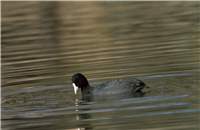Family
Rallidae
Genus
Fulica
Species
atra
Threats/Control Methods - Regional
This species is threatened by the diversion of water away from naturally flowing rivers and wetlands into irrigation and human use, and the declining water quality from stock grazing and industrial run-off.
Threats/Control Methods - Local
Water bodies in urban areas are less resilient against periods of droughts or extreme weather events, causing a build-up of toxins and dangerous algae levels, which may impact the health of this species. This species relies on a range of healthy water species for feeding and is therefore impacted if water sources become polluted. The abundant Purple Swamphen (Porphyrio porphyrio ) is the major predator of their young.
Local/Urban Actions
There are many simple precautions residents can take to ensure waterways remain unpolluted. Chemical fluids should go to specific waste management sites. The Canberra Connect helpline on (02) 6207 9777, has all the information on specific chemical waste disposal questions. It is also helpful to avoid vegetation, dirt or mulch building up in gutters and drains by raking it up off the street or concreted areas and then placing it into the compost or taking it to 'Corkhill Brothers' at Mugga Lane Landfill or 'Canberra Sand and Gravel' at Parkwood Road Recycling Estate.
Common Names
Eurasian Coot, Coot, Black Coot, Common Coot, European Coot
Distinguishing Features
This is an easily recognised species, with all-black plumage and a white bill and head shield. The eye is red on its relatively small head. The legs and feets are slate-grey coloured and half-webbed. Young birds are pale grey beneath, with a white throat and a smaller head shield.
Survey Techniques
Call and visual identification.
Species Call
A variety of harsh notes, a sharp 'kyik!' and a grating 'kiek-keik-keik'.
Similar Species
The Eurasian Coot is a distinct looking species.
Distribution
This species is found in permanently high numbers in deep wetlands across the Australian continent, following rain events and searching for water bodies in drier regions. It is also very common and abundant across New Zealand, Europe and Asia.
Country of Origin
Europe or Asia
Conservation (Pet/Pest) Status - Regional
Coots are very common across well-watered areas of the region. However, in regional parts of NSW they have been recognised as a significantly declining species in response to water being pumped out of the natural waterways for irrigation.
Conservation (Pet/Pest) Status - National
Secure, not listed under the EPBC Act 1999.
LSCCES Population
Many birds were seen at the waterfront around the NMA, with others in Civic West, ANU and BMP.
Associated vegetation community
Coots can be seen in almost any wetland environment, preferring freshwater in rivers, lakes and swamps, urban waterways or sewage farms.
Limiting Resources
Water bodies must be surrounded by thick vegetation in order for Eurasian Coots to breed successfully. Deep water bodies with an abundance of healthy aquatic vegetation and algae is also required.
Breeding
The breeding season runs from September to December, however it is also influenced by a good rain event in drier regions. Both parents share all the responsibilities for the single brood produced each year. Nests are constructed in the edging shallows by building up a heap of vegetation into a large bowl, which floats among the reeds or logs. 5-7 cream coloured and lightly speckled eggs are laid at 24-hour intervals, needing 23-26 days of incubation.
Behaviour
This species spends most of its time in open waters, rarely coming to shore to feed on grasses. They are active feeders during the day, but when travelling, they prefer the cover of night. Throughout most of the year they are highly social and spend time in large groups on the open water, squabbling, wing flapping and bobbing about together. During the breeding season, pairs become very territorial and chase away other birds with vigour.
Functional Group
Food Species
Coots usually feed in the open water, diving for aquatic plants and algae.
Predators
The fluffy Coot chicks are very vulnerable to a variety of hungry predators, including Black Rats (Rattus Rattus), Silver Gulls (Larus novaehollandiae ), Swamp Harriers (Circus aeruginosus) and Purple Swamphens (Porphyrio porphyrio ).
Interesting Fact
This species is particularly aggressive in the breeding season, when pairs are known to steal the nests of other waterbirds, rolling the eggs of the other birds into the water.
References - (reader suitability of references, P=Primary teachers, S=Secondary students, T=Tertiary students and researchers)
Books:Morcombe, M. 2000. Field Guide to Australian Birds. Steve Parish Publishing. Archerfield. Australia P, S, T
Pringle, J. 1985. The Waterbirds of Australia. Angus and Robertson/National Photographic Index of Australian Wildlife, Sydney. S, T
Veerman, P. 2003. Canberra Birds: A report on the first 21 years of the garden bird survey. Philip Veerman and Canberra Ornithologists Group. Canberra. S, T
Internet: Birds in Backyards. 2006. [online]. Available at:http://www.birdsinbackyards.net P, S, T
Canberra Ornithological Group (COG). 2004. Birds of Canberra Gardens. COG and the ACT Department of Urban Services. [online]. Available at:http://garden.canberrabirds.org.au/ P, S, T
Online Publications:ACT Government. 2006. Information Sheet: Stormwater Pollution from Residential Areas. Environment ACT. [online]. Available at: http://www.environment.act.gov.au/__data/assets/pdf_file/13168/Stormwater_Pollution_from_Residential_Areas.pdf P, S, T
Nix, H. and Cunningham, R. 2006. Birds of the Lower Sullivans Creek Catchment, Canberra ACT. Prepared for the Life in the Suburbs project using data from the Lower Sullivans Creek Catchment Ecological Survey (LSCCES). Australian National University. Canberra. [online]. Available at: http://www.lifeinthesuburbs.com.au/category.php?id=65 S, T
Olsen, P. and Weston, M. 2004. The State of Australian Birds 2004: Water Wetlands and Birds. Birds Australia. [online] Available at: http://www.environment.gov.au/biodiversity/publications/birds-04/regional.html S, T

 Top
Top Top
Top